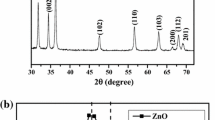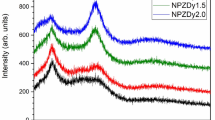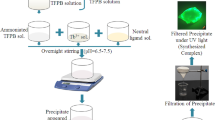Abstract
We synthesized some Eu(III) complexes {[Eu(dpa)(α-pc)(CH3OH)]·2CH3OH} (1), {[Eu(dpa)(2-ap)(CH3OH)]·2CH3OH}(2) and {[Eu(dpa)(2-hp)(CH3OH)]·2CH3OH}(3) [dpa = dipicolinic acid; α-pc = α-picolinic acid; 2-ap = 2-aminopyridine; 2-hp = 2-hydroxypyridine]. The structural characterization of the complexes were studied by elemental analysis, FTIR spectroscopy, SEM and powder X-ray diffraction studies (XRD) where the elemental analysis and FTIR results indicate the coordination of ligands with the Eu(III) ion. The X-ray diffraction patterns show the crystalline nature of complex (1) and amorphous nature of complexes (2) and (3) and the SEM micrographs also depict different morphologies of the complexes. The thermal properties of the synthesized complexes were studied by TG–DTA technique which indicates good thermal stability of the synthesized complexes. The optical properties were studied using Ultraviolet visible spectroscopy (UV–Vis) and Photoluminescence studies (PL) where photoluminescence measurements indicate that all the three complexes exhibit the characteristic emission bands of Eu(III) ion corresponding to 5Do → 7FJ (J = 0–4) transitions and it has also been observed that the intensity of emission is influenced by the effect of different secondary ligands. The most intense transition and the long radiative lifetime, quantum efficiency of the 5Do excited level of Eu(III) ion observed for the complex (2) with 2-ap as secondary ligand reflects the good sensitizing ability of ligand 2-ap. The optical properties of the obtained complexes can be well utilized for preparation of rare earth luminescent materials and fluorescence probes.








Similar content being viewed by others
References
J.H. Xue, X.H. Hua, L.M. Yang, W.H. Li, Y.Z. Xu, G.Z. Zhao, G.H. Zhang, K.X. Liu, J.E. Chen, J.G. Wu, Synthesis, crystal structures and luminescence properties of europium and terbium picolinamide complexes. Chin. Chem. Lett. 25, 887–891 (2014)
L. Meijuan, W. Xiaoping, T. Qiang, L. Qidan, Luminescence properties of polymers containing europium complexes with 4-tert-butylbenzoic acid. J. Rare Earths 31, 950–956 (2013)
K.P. Zhuravlev, V.I. Tsaryuk, I.S. Pekareva, J. Sokolnicki, Z.S. Klemenkova, Europium and terbium ortho-, meta-, and para-methoxybenzoates: Structural peculiarities, luminescence, and energy transfer. J. Photochem. Photobiol. A 219(219), 139–147 (2011)
M. Rasanen, H. Takalo, J. Rosenberg, J. Makela, K. Haapakka, J. Kankare, Study on photophysical properties of Eu(III) complexes with aromatic β-diketones—Role of charge transfer states in the energy migration. J. Lumin. 146, 211–217 (2014)
M.G. Lahoud, L.F. Marques, P.B. Da Silva, C.A. De Jesus, C.C. Da Silva, J. Ellena, R.S. Freits, M.R. Davolos, C.G. Frem Regima, Synthesis, crystal structure and photoluminescence of a binuclear complex of europium(III) containing 3,5-dicarboxypyrazolate and succinate. Polyhedron 54(54), 1–7 (2013)
G. Zucchi, O. Maury, P. Thurey, M. Ephritikhine, Structural diversity in Neodimium bipyrimidine compounds with near infrared luminescence: From mono and binuclear complexes to metal-organic frameworks. Inorg. Chem. 47, 10398–10406 (2008)
L. Armelao, S. Quici, G.A. Barigelletti, G. Bottaro, M. Cavazzini, E. Tondello, Design of luminescent lanthanide complexes : From molecules to highly efficient photo-emitting materials. Coord. Chem. Rev. 254, 487–505 (2010)
G.F. De Sa, O.L. Malta, C. de Mello Donega, A.M. Simas, R.L. Longo, P.A. Santacruz, E.F. Da Silva Jr., Spectroscopic properties and design of highly luminescent lanthanide coordination complexes. Coord. Chem. Rev. 196, 165–195 (2000)
H.A. Azab, A. Duerko, Z.M. Anwar, B.H.M. Hussein, M.A. Rizk, Luminescence recognition of different organophosphorus pesticides by the luminescent Eu(III)-pyridine-2,6-dicarboxylic acid probe. Anal. Chim. Acta 759, 81–91 (2013)
H. Zheng, D. Gao, F. Zhenxing, E. Wang, Y. Lei, Y. Tuan, M. Cui, Fluorescence enhancement of Ln3+ doped nanoparticles. J. Lumin. 131, 423–428 (2011)
L. Zhang, Y. An, W. Ahmad, Y. Zhou, Z. Shi, X. Zheng, A new quarternary luminescence enhancement system of Eu-N-(3-methoxysalicylidene)-2-aminopyridine-1,10-phenanthroline-Zn and its application in determining trace amounts of Eu3+ and Zn2+. J. Photochem. Photobiol. A 252, 167–173 (2013)
Z. Hnatejko, G. Dutkiewicz, M. Kubicki, S. Lis, New complexes of cobalt(II) ions with pyridine carboxylic acid N-oxides and 4,4′-byp. J. Mol. Struct. 1034, 128–133 (2013)
G.X. Liu, Y.Y. Xu, X.M. Ren, S. Nishihara, R.Y. Huang, Self–assembly of 3d-4f coordination frameworks based on pyridine-3,5-dicarboxylic acid: Synthesis, crystal structuresand luminescence. Inorg. Chim. Acta 363, 3727–3732 (2010)
R. Tang, Q. Zhao, Z.E. Yan, Y.M. Luo, Synthesis of novel derivatives of pyridine-2,6-dicarboxylic acid. Synth. Commun. 36, 2027–2034 (2006)
Q. Yue, J. Yang, G.H. Li, G.D. Li, W. Xu, J.S. Chen, S.N. Wang, Three dimensional 3d-4f Heterometallic coordination polymers: Synthesis. Struct. Magn. Prop. Inorg. Chem. 44, 5241–5246 (2005)
J.C.G. Bunzli, Lanthanide Luminescence for biomedical analyses and imaging. Chem. Rev. 110, 2729–2755 (2010)
H. Tsukube, S. Shinoda, Lanthanide complexes in molecular recognition and chirality sensing of biological substrates. Chem. Rev. 102, 2389–2403 (2002)
D.T. De Lill, D.A. Bettencourt, C.L. Cahill, Exploring Lanthanide luminescence in Metal-Organic Frameworks: Synthesis, Structure and Guest-Sensitized Luminescence of a mixed Europium/Terbium-Adipate Framework and a Terbium-Adipate Framework. Inorg. Chem. 46, 3960–3965 (2007)
D. Ma, W. Wang, Y. Li, J. Li, C. Daiguebonne, G. Calvez, O. Guillou, In situ 2,5-pyrazinedicarboxylate and oxalate ligands synthesis leading to a microporous europium-organic framework capable of selective sensing of small molecules. Cryst. Eng. Comm. 12, 4372–4377 (2010)
J. Huang, Y. Xu, X. Chen, D. Xu, Y. Xu, Q. He, Synthesis, characterization and properties of some rare earth complexes with 2,6-pyridine dicarboxylic acid and α-Picolinic acid. J. Rare Earths 30, 586–591 (2012)
S. Mistri, E. Zangrando, S.C. Manna, Cu(II) complexes of pyridine-2,6-dicarboxylate and N-donor neutral ligands: Synthesis, crystal structure, thermal behavior, DFT calculation and effect of aromatic compounds on their fluorescence. Inorg. Chim. Acta 405, 331–338 (2013)
S.P. Jose, S. Mohan, Vibrational spectra and normal co-ordinate analysis of 2-aminopyridine and 2-aminopicoline. Spectrochimica. Acta. Part A. 64, 240–245 (2006)
D. Wang, Y. Pi, C. Zheng, L. Fan, Y. Hu, X. Wei, Preparation and photoluminescence of some europium (III) ternary complexes with β-diketone and nitrogen heterocyclic ligands. J. Alloy. Compd. 574, 54–58 (2013)
R. Lyszczek, L. Mazur, Polynuclear complexes constructed by lanthanides and pyridine-3,5-dicarboxylate ligand: Structures, thermal and luminescent properties. Polyhedron 41, 7–19 (2012)
M.E. Mesquita, S.S. Nobre, M. Fernandes, R.A.S. Ferreira, S.C.G. Santos, M.O. Rodrigues, L.D. Carlos, V. de Zea Bermudes, Highly luminescent di-ureasil hybrid doped with a Eu(III) complex including dipicolinate ligands. J. Photochem. Photobiol. A 205, 156–160 (2009)
M.R. George, C.A. Golden, M.C. Grossel, R.J. Curry, Modified dipicolinic acid ligands for sensitization of Europium(III) luminescence. Inorg. Chem. 45, 1739–1744 (2006)
A.A. Picot, P.L. Baldeck, C. Andraud, O. Maury, Design of dipicolinic acid ligands for the two-photon sensitized luminescence of europium complexes with optimized cross- sections. Inorg. Chem. 47, 10269–10279 (2008)
Acknowledgments
The authors would like to thank Guru Gobind Singh Indraprastha University, New Delhi for providing financial support as Indraprastha Research Fellowship for research work.
Author information
Authors and Affiliations
Corresponding author
Rights and permissions
About this article
Cite this article
Sharma, G., Narula, A.K. Synthesis and optoelectronic properties of three Eu(III)-dipicolinate complexes based on α-picolinic acid, 2-aminopyridine and 2-hydroxypyridine as secondary ligands. J Mater Sci: Mater Electron 26, 1009–1017 (2015). https://doi.org/10.1007/s10854-014-2497-7
Received:
Accepted:
Published:
Issue Date:
DOI: https://doi.org/10.1007/s10854-014-2497-7




